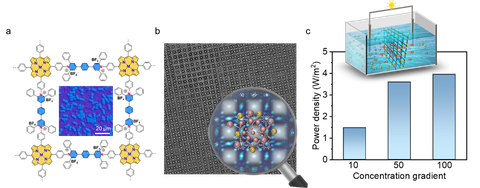07.12.2021
On-water surface synthesis of charged 2D polymer single crystals via the irreversible Katritzky reaction

Figure (a) Structure of C2DP with a square lattice (a = b = 30.5 Å). Inset, Optical microscopy image of C2DP film. (b) Aberration Corrected High-Resolution Transmission Electron Microscopy (AC-HRTEM) image of C2DP acquired with a total electron dose of 70 e- Å-2. (c) C2DP-based osmotic power generation under salinity gradient.
The exploration of kinetically irreversible bond formation for the synthesis of two-dimensional polymers (2DPs) and their layer-stacked 2D covalent organic frameworks (2D COFs) has remained scarce, mostly due to the incomplete reactions or polymorphism, as well as the lack of error-correction. By far, only the recent achievements using Knoevenagel (Polym. Chem. 7, 4176-4181 (2016), Science 357, 673-676 (2017)), Aldol-type (J. Am. Chem. Soc. 141, 6848-6852 (2019)) and Horner-Wadsworth-Emmons condensation reactions (Angew. Chem. Int. Ed. 59, 23620-23625 (2020)) have demonstrated the possibility of synthesizing crystalline 2D COFs from solution syntheses. To access single-layer 2DPs via aryl-aryl coupling, the on-surface assisted Ullmann-type coupling under ultrahigh vacuum conditions has received much attention in the last decade (Nat. Chem. 9, 563-570 (2017), Nat. Mater. 19, 874-880 (2020)). Nevertheless, these approaches have remained limited to making microcrystalline products with domain sizes up to dozens of nanometers. Therefore, the synthesis of single-crystalline 2DPs and 2D COFs via irreversible reactions constitutes an immense challenge.
The researchers from Prof. Xinliang Feng and Dr. Renhao Dong’s group recently reported the synthesis of few-layer, large-area, single-crystalline cationic 2DPs (C2DPs) through an irreversible Katritzky reaction on the water surface. Probing the interfacial ring-transmutation polymerization mechanism by theoretical calculation and model reaction, unveils that manipulating pH in ring opening and ring closure steps controls the reaction kinetics toward the C2DP structures. As a consequence, the researchers demonstrate the synthesis of C2DP single crystals by irreversible reactions under kinetic control. Representatively, the C2DP single crystals display a tunable thickness of ~ 2-30 nm, and a lateral size up to 120 µm2, which is far beyond the thus-far reported 2DPs and 2D COFs synthesized by the irreversible bonds. The crystal structure with the atomic precision is resolved by imaging and diffraction methods, revealing a highly uniform square-patterned structure with the in-plane lattice of a = b = 30.5 Å. The positively-charged framework is counterbalanced by BF4- ions and is characterized by spectroscopy and single-crystal analysis of a representative example.
Significantly, the C2DP crystals with cationic polymer skeleton and columnar-like pore arrays offer a high chloride ion selectivity with a coefficient up to 0.9, thus ensuring the integration as the anion-selective membrane for the osmotic energy generation. As a result, an output power density as high as 4.0 W m-2 is achieved which outperforms the state-of-art 2D materials such as graphene and boron nitride. These achievements reveal a route for synthesizing 2DP and 2D COF single crystals using a kinetically-controlled irreversible reaction, and will spark further efforts to rationally design crystalline 2DPs with charged backbones towards osmotic power generation.
Reference: Zhiyong Wang, Zhen Zhang, Haoyuan Qi, Andres Ortega-Guerrero, Lihuan Wang, Kun Xu, Mingchao Wang, SangWook Park, Felix Hennersdorf, Arezoo Dianat, Alexander Croy, Hartmut Komber, Gianaurelio Cuniberti, Jan J. Weigand, Ute Kaiser, Renhao Dong, and Xinliang Feng, On-water surface synthesis of charged two-dimensional polymer single crystals via the irreversible Katritzky reaction, Nature Synthesis, 2022, DOI: 10.1038/s44160-021-00001-4.
https://www.nature.com/articles/s44160-021-00001-4
Acknowledgments: This work is financially supported by EU Graphene Flagship (GrapheneCore3, No. 881603), ERC starting grant (FC2DMOF, No. 852909), ERC Consolidator Grant (T2DCP), DFG project (2D polyanilines, No. 426572620), Coordination Networks: Building Blocks for Functional Systems (SPP 1928, COORNET), H2020-MSCA-ITN (ULTIMATE, No. 813036), H2020-FETOPEN (PROGENY, 899205), CRC 1415 (Chemistry of Synthetic Two-Dimensional Materials, No. 417590517), SPP 2244 (2DMP), as well as the German Science Council and Center of Advancing Electronics Dresden. Z. W. gratefully acknowledges funding from China Scholarship Council. The authors acknowledge Center of Advancing Electronics Dresden and Dresden Center for Nanoanalysis at TUD and Dr. Petr Formanek, Prof. Andreas Fery for the use of TEM facility at IPF.
